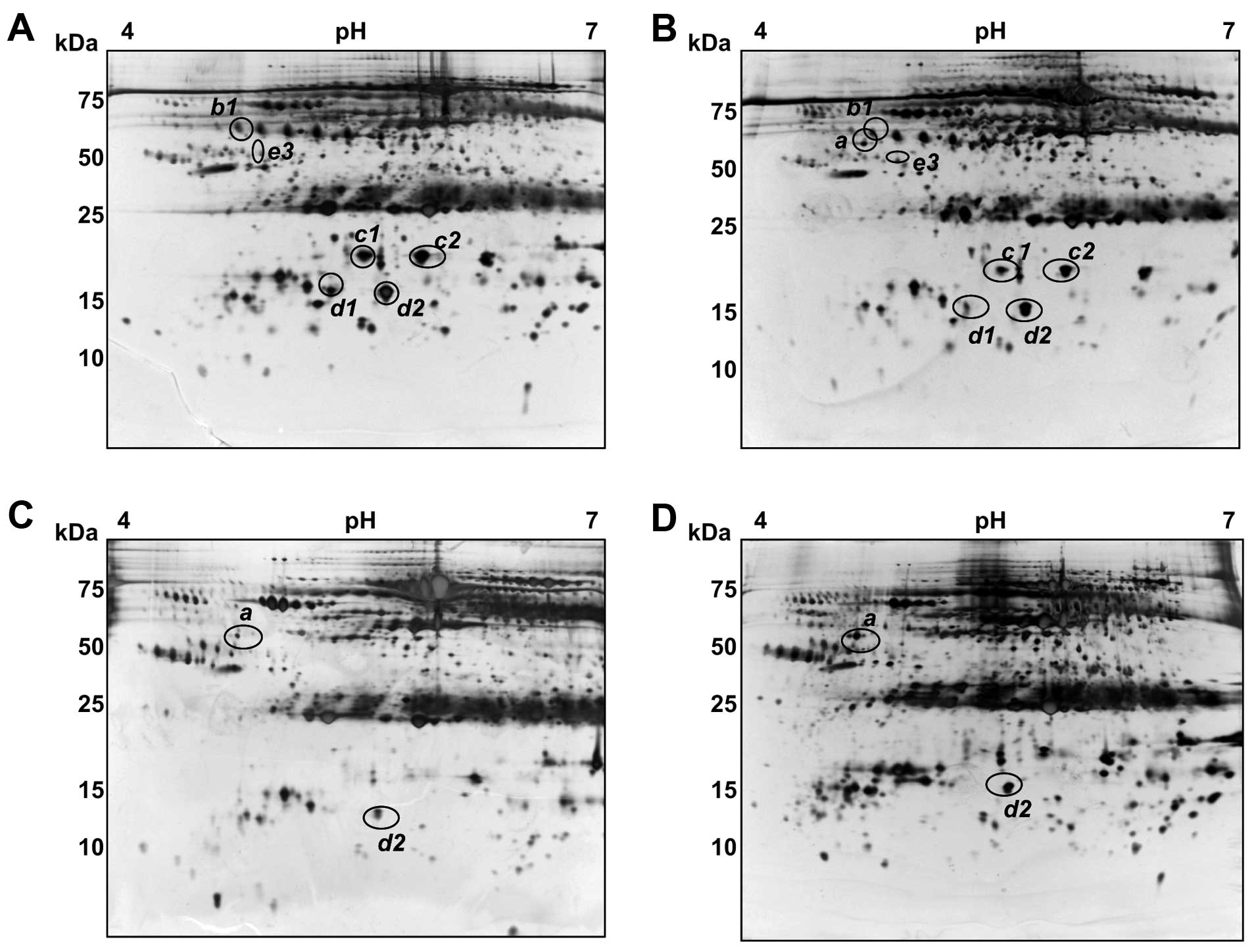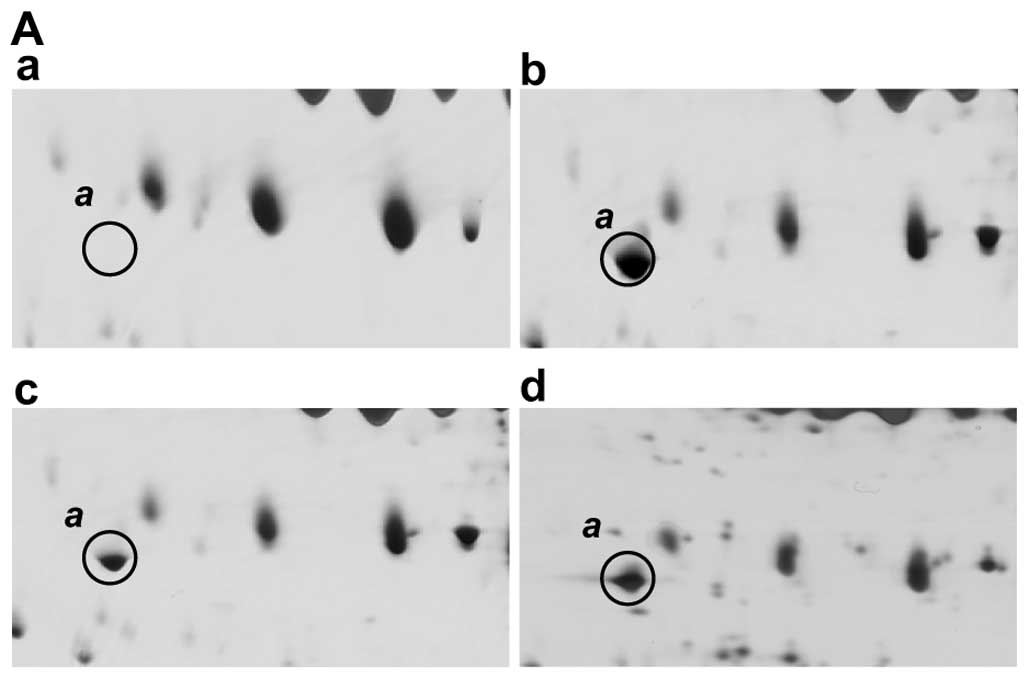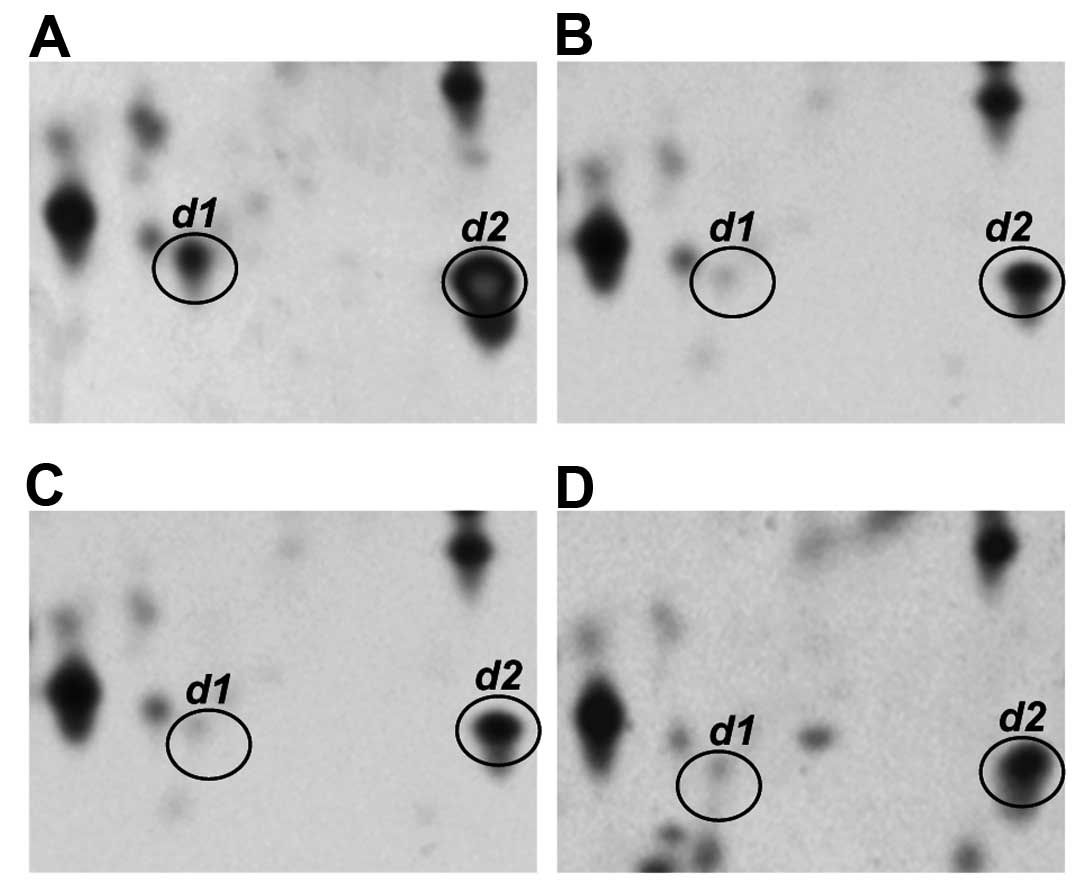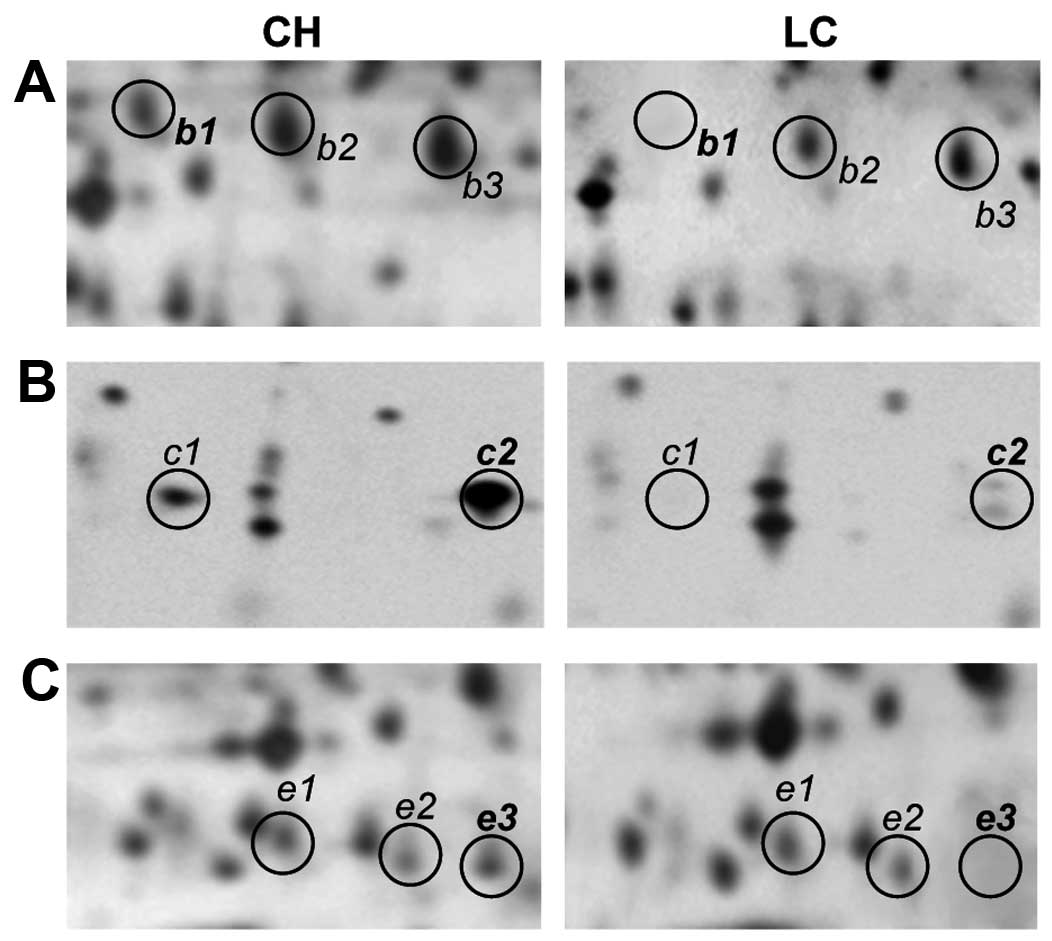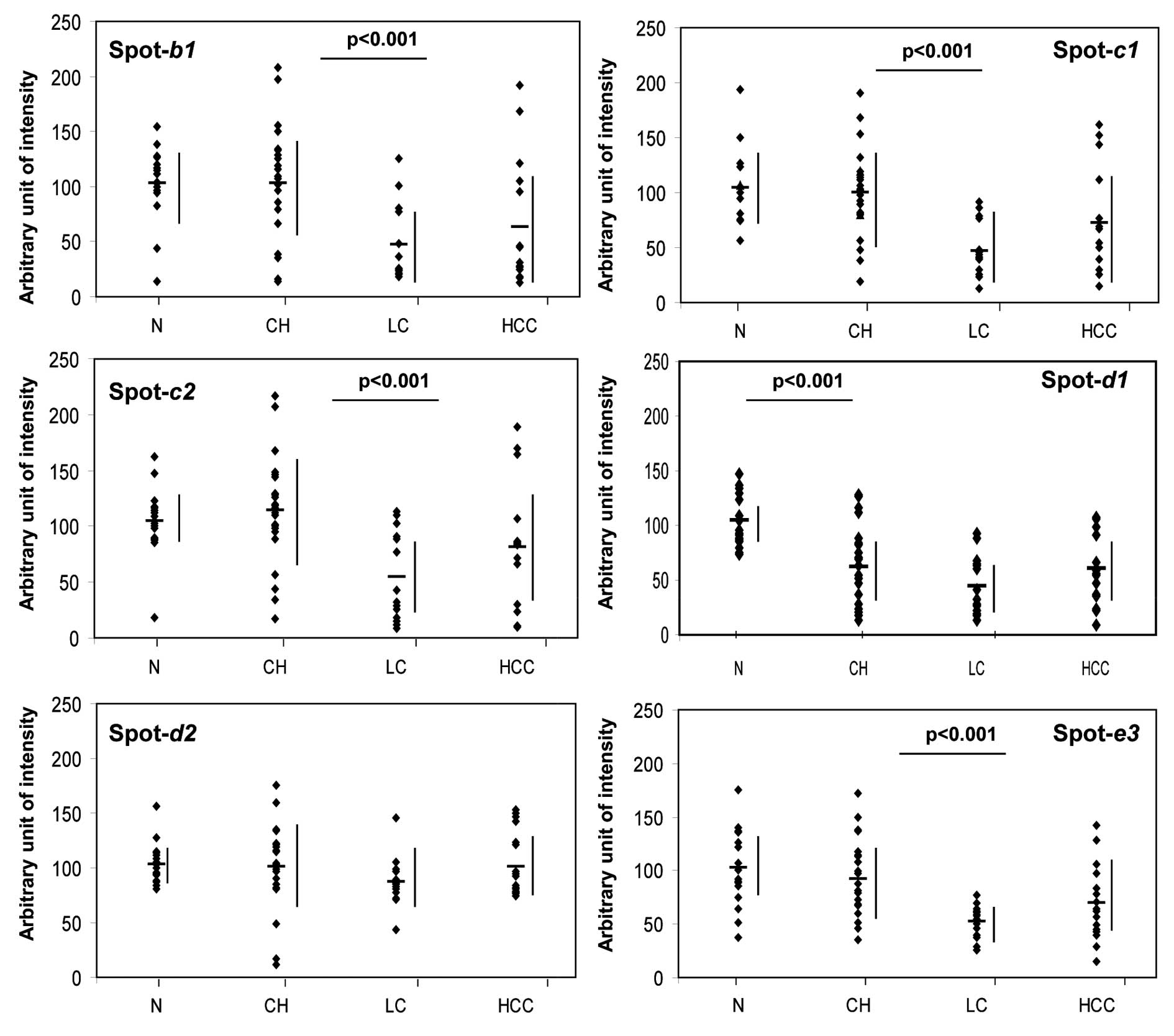Serum protein isoform profiles indicate the progression of hepatitis C virus-induced liver diseases
- Authors:
- Published online on: February 4, 2013 https://doi.org/10.3892/ijmm.2013.1267
- Pages: 943-950
Abstract
Introduction
Over 170 million people worldwide are estimated to be chronically infected with the hepatitis C virus (HCV). HCV carriers often develop chronic hepatitis (CH), liver cirrhosis (LC), and hepatocellular carcinoma (HCC) after incubation periods of 15, 25 and 30 years on average, respectively (1). HCC is one of the most fatal forms of cancer and has an increasing incidence in many countries. The HCV is the most clearly established risk factor for HCC. Despite the current availability of anti-viral therapies, 25% of individuals with chronic HCV infection are likely to develop advanced liver cirrhosis within 20 years (2). Furthermore, >70% of the cases of HCV-induced LC are destined to develop HCC (3). Hence, the current diagnostic strategies for these diseases emphasize approaches that differentiate LC from CH, i.e., the progression of fibrosis in the liver, in addition to the early detection of HCC. Reliable, noninvasive methods for assessing the progression of LC are not presently available, however. Histological examination of the liver following a biopsy is the current standard for diagnosing LC but this is an invasive method and carries the potential risk of internal bleeding. In addition, as a consequence of a liver biopsy procedure, 30% of patients feel pain, 0.3% have severe complications, and 0.03% die (4). Moreover, as biopsy of the liver can detect only a small part of the whole organ, it is sometimes difficult to correctly identify the stage of fibrosis with this method. Furthermore, whereas gross cirrhosis can be detected by computed tomography scanning, this cannot be used to detect early cirrhosis. Several biochemical markers such as hyaluronic acid do have substantial predictive values for the diagnosis of cirrhosis, but no biomarkers are available that allow for a completely accurate diagnosis.
In clinical proteomics, two-dimensional polyacrylamide gel electrophoresis (2D-PAGE)-based proteomic analysis is a powerful technique for comparing different protein expression profiles between normal and either diseased or drug-treated samples. This includes protein expression levels, the presence of isoforms generated by alternative splicing, cleavage by proteases, and post-translational modifications. 2D-PAGE also provides information on potential new biomarkers, disease-associated targets and pathogenic processes. Moreover, protein isoform profiles revealed by 2D-PAGE have been reported to be characteristic of diseases such as cancer (5,6), neurodegenerative disorders (7,8) and Creutzfeldt-Jakob disease (9). In particular, some isoforms of serum proteins have been reported to be potential diagnostic markers of hepatitis B-associated liver inflammation (10), hepatocellular carcinoma (11) and coronary heart disease (12). However, although proteomics has been extensively employed to investigate disease-specific proteins, there are currently few studies of HCV-infected hepatitis and cirrhosis cases that seek to establish non-invasive diagnoses for these patients.
In our current study, we attempted to isolate novel specific biomarker proteins for HCV-induced liver diseases in the sera of patients with CH, LC and HCC using 2D-PAGE. We analyzed any differentially expressed proteins in these experiments by peptide mass fingerprinting (PMF) and MS/MS analysis and we report the identification of a number of serum proteins and their isoforms that show significantly different expression profiles in the specific disease states under study.
Materials and methods
Serum samples
We analyzed serum samples obtained from 24 HCV-induced CH, 17 LC, and 19 HCC patients. As a control group we further assessed 19 normal healthy individuals. Patients who were positive for both antibodies to HCV by third-generation enzyme-linked immunosorbent assay (Lumipulse II, Ortho HCV; Ortho Clinical Diagnostics), and who also had detectable HCV-RNA in their sera by RT-PCR (Amplicor HCV Amplification kit; Roche), were diagnosed as having HCV-related liver disease. The serum samples used in this study were all negative for HBV infection. CH and LC were diagnosed by histological examination of biopsied samples. Some cases were diagnosed as LC based on clinical findings without liver biopsy, such as hepatic failure, ascites or an esophageal varix. A diagnosis of HCC was mainly established by radiological findings and elevated values for tumor markers. A biopsy was not performed if a finding that was indicative of HCC was obtained by ultrasonography, computed tomography, or a CT during hepatic arteriography and arterial portography. Normal healthy sera were collected from liver transplantation donors who showed no evidence of disease.
All serum samples were collected and processed in the same manner with the informed consent of each patient, and were subsequently used in accordance with procedures approved by the Ethics Committee of Mie University, University of Tsukuba, and the National Institute of Advanced Industrial Science and Technology (AIST). The protein content of each serum sample was determined by a Bradford assay (Bio-Rad).
2D-PAGE of serum proteins
Serum proteins (100 μg aliquots) were applied to immobiline dry strips (pH 4–7, 12 cm; Amersham) in a total volume of 125 μl containing 8 M urea, 2% CHAPS, 0.5% immobilized pH gradient buffer (Amersham) and 2.8 mg/ml dithiothreitol. Following isoelectric focusing, the strips were equilibrated twice in 50 mM Tris containing 6 M urea, 30% glycerol and 2% SDS for 10 min. Dithiothreitol was then added, followed by iodoacetamide. The second dimension for resolution was 12.5% non gradient SDS-PAGE (16×12 cm) in two steps: 600 V, 20 mA for 30 min and 600 V, 50 mA for 70 min. The resolved protein spots were then fixed for silver staining by Dodeca™ Silver Stain kit (Bio-Rad) according to the manufacturer’s instructions.
Image acquisition and analysis
Silver stained gels were scanned and intensity calibrations were carried out using an intensity stepwedge prior to gel image capture. Image analysis was subsequently carried out using ImageMaster 2D Elite software 4.01 (Amersham). Protein spots were initially detected, matched and then manually edited. Protein spots showing significant differences in intensity (>1.5-fold increase or decrease) between the different diseases were selected for analysis by mass spectrometry.
In-gel digestion
Selected protein spots including isoforms were excised and transferred into siliconized 1.5 ml microtubes. The silver dye was removed by incubation with 15 mM potassium hexacyanoferrate (III) (potassium ferricyanide) containing 100 mM sodium thiosulfate for 30 min, and rinsing five times in ultra-pure water for 5 min each. The gel piece was then dehydrated in 100% acetonitrile, and dried using a vacuum desiccator. A 3 μl aliquot of sequencing-grade trypsin (30 μg/ml; Promega) in 50 mM ammonium bicarbonate containing 0.1% n-octyl glucoside was then added, and the gel piece was reswollen by incubating on ice for 10 min. After this swelling, 27 μl of 50 mM ammonium bicarbonate was added slowly. In-gel digestion was then performed overnight at 36°C. The peptides were adsorbed using a PerfectPure C-18 tip (Eppendorf), desalted, and then extracted with 2 μl matrix solution (5 mg/ml a-cyano-4-hydroxycinnamic acid in 50% acetonitrile and 0.1% trifluoroacetic acid), and mixed with 100 fmol/μl bradykinin fragment 1–7 (Wako) and 100 fmol/μl ACTH fragment 18–39 (Sigma) on a matrix-assisted laser desorption/ionization (MALDI) target plate.
Mass spectrometry and PMF
Matrix-assisted laser desorption/ionization-time of flight mass spectrometry (MALDI-TOF MS) for PMF was performed using an AXIMA-CFR plus mass spectrometer (Shimadzu) in reflectron mode. MS/MS analysis was performed using an AXIMA-QIT device (Shimadzu). The results of the peptide identification by PMF and MS/MS were scored by the Mascot database search engine (Matrix Science), and the top-scoring gene products with a Mascot value of >30 (and/or judged by Mascot to be more than ‘significant’), were designated as the corresponding proteins.
Results
Comparison between the serum protein profiles from HCV-induced disease patients and healthy controls
Sera from healthy controls and three groups of HCV-induced disease patients were applied to 2D-PAGE and the resolved proteins were visualized by silver staining. 2D-PAGE was performed either twice or three times for each sample and the intensity of the spots was then calculated to minimize gel-to-gel variation. Fig. 1 shows representative gel images for normal healthy, and from CH, LC and HCC patients. Overall, the serum patterns for normal healthy and CH patients were found to be very similar to the plasma map of the SWISS 2D database (http://www.expasy.ch/ch2d/), except for the lack of fibrinogen due to the use of serum instead of blood plasma. More than 800 spots were detected in these analyses, ranging from 10–150 kDa in size with pIs of between 4 and 7. Several trains of spots represented proteins whose primary structures harbored different degrees of glycosylation and/or phosphorylation, resulting in a progressive change in both the pI and molecular weight (Mr). Spot intensity comparisons were made between the four groups of samples using Image Master software and significant differences were found for at least seven spots among eleven protein spots, which we designated as a, b1, b2, b3, c1, c2, d1, d2, e1, e2 and e3 (Fig. 1).
Protein identification
The eleven spots including differentially expressed protein spots shown in Fig. 1 were excised and subjected to tryptic digestion, MALDI-TOF MS and database searching using Mascot software. The protein identities were then confirmed by comparison with the SWISS database plasma map (Table I). Some spots were confirmed by MS/MS analyses using AXIMA-QIT.
Table IIdentification of the protein spots observed to be differentially expressed in HCV-associated liver diseases. |
The C-terminal fragment of C3 is detectable in HCV-infected patient sera
Fig. 2A shows the 2D-PAGE results for spot a which is present in each of the HCV-infected patients but is absent from normal healthy sera. This protein has an Mr of between 40–45 kDa, and a pI ranging from 4.5 to 5.0, and both PMF and MS/MS analyses identified it as a fragment of complement C3 (Fig. 2B). This C3 fragment was identified from among the 14 peptides that match the C-terminal fragment of the complement C3 precursor (Table I). The matched peptides are found only in the C-terminal region of the C3 protein from residue position 1321 (Fig. 2B). A MEROPS database search (http://merops.sanger.ac.uk/) also indicates that a potential protease, complement factor I, cleaves the sites at 1303, located in the C3 α-chain, during the inactivation of C3b and in the presence of cofactors. This cleavage activity produces a fragment with a theoretical mass of 41,492 Da and a pI of 4.96, which is consistent with the migratory properties of spot a in our 2D-PAGE gels (Fig. 1). The sequence coverage of the matched peptides from position 1304 to the C-terminus of C3 is 42%.
An isoform of transthyretin shows decreased expression in the sera of CH patients
Fig. 3 shows representative profiles of the transthyretin monomer (spot d1 and d2) in the sera of normal individuals and of patients with CH, LC and HCC. Two isoforms of this protein, designated as spots d1 and d2, with different pI values (4.8 vs. 6.0, respectively) were observed in the normal control. However, spot d1, which is the more acidic transthyretin isoform, was clearly present at decreased serum levels in the CH, LC and HCC patients.
Isoforms of haptoglobin, haptoglobin α2-chain and apolipoprotein A-IV (apo A-IV) show decreased expression in the sera of LC and HCC patients
Fig. 4 displays representative patterns of expression for isoforms of haptoglobin (b1, b2 and b3), haptoglobin α2-chain (c1 and c2) and apo A-IV (e1, e2 and e3) in the sera of both CH and LC patients. Haptoglobin, haptoglobin α2-chain and apo A-IV exhibit characteristic train patterns in 2D gels, featuring three, two and three detectable isoforms, respectively. No change was found in the expression pattern of these isoforms in either normal or CH sera, whereas a significant reduction in the expression levels of these proteins could be observed in the sera of LC and HCC patients. In particular, spots b1, c1, c2 and e3 were at greatly reduced levels in the LC patients, compared with the CH patients.
Comparative quantification of the differentially expressed protein isoforms in sera from HCV-infected patients
To normalize and compare the expression levels of the protein spots b1, c1, c2, d1, d2 and e3 among the different liver diseases, we selected an additional seven spots which demonstrated almost constant levels of expression, regardless of the origin of the serum sample. These seven proteins were expressed with almost equal intensity in four groups of samples (Fig. 5). In addition, the standard deviation (SD) from the mean expression levels of these factors in each group was <10%, indicating that they could serve as suitable standards. By contrast, the expression of the spots b1, c1, c2, d1 and e3 changed significantly, and these changes paralleled the differences in the stage of the liver disease (Fig. 5; see figure legend for the calculation of arbitrary units of intensity).
We next generated scatter diagrams for each of the disease-related protein and isoform expression patterns (Fig. 6) and again confirmed that the expression changes of b1, c1, c2, d1 and e3 seem to mirror the progress of the associated liver disease stage. Whereas d1 was found to be at low levels in all of the liver diseases tested, the intensity of each of the other spots was significantly decreased (p<0.001) with the progression from CH to LC. Moreover, the expression of the d1 isoform of transthyretin also changed significantly (p<0.001) and showed an appreciable reduction as early as the CH stage of liver disease, whereas the d2 isoform did not show this pattern (Figs. 5 and 6).
Identification of potential diagnostic markers for CH and LC
Our present data suggest that the profiling of our 2D-PAGE protein isoforms a, b1, c1, c2, d1 and e3 could be effectively utilized in the diagnosis of CH and LC. Table II shows the diagnostic values (AUC) for these proteins and indicates that both complement C3 fragment (a) and transthyretin (d1) exhibit a high value (AUC=0.95 and 0.83, respectively) and may be utilized to distinguish CH from a healthy liver. To distinguish LC from CH, the haptoglobin isoform b1, the haptoglobin α2-chain isoforms c1 and c2, and the apo A-IV isoform e3 also show high diagnostic values (0.91, 0.80, 0.85 and 0.89, respectively). Based on the assumption that a spot showing an intensity of <66.7 units (i.e., an intensity lower than the mean minus 1 SD) is significant, the sensitivity and the specificity of the b1, c2 and e3 spots as disease biomarkers that can segregate LC from CH cases are 60 and 96%, 60 and 83%, and 75 and 96%, respectively. In addition, if the b1 and e3 markers are used in combination, cases of LC could be more accurately diagnosed from CH with an 85% sensitivity and 96% specificity (data not shown).
Table IIAssessment of the identified differentially expressed proteins as potential diagnostic biomarkers for HCV-induced liver diseases. |
Discussion
In our current study, we found that isoforms of transthyretin, haptoglobin and apo A-IV are at reduced levels in sera from HCV disease patients. The former two of these proteins are among the most abundant serum glycoproteins known to be secreted by the liver (13). It is therefore plausible to predict that liver damage would result from alterations in the expression profiles of these factors, or from protein modifications. Such changes, therefore, have the potential to be used as biomarkers for monitoring liver diseases. The combined use of these novel diagnostic markers and conventional serum markers could improve the diagnosis of HCV disease and reduce the number of liver biopsies performed in patients with chronic HCV infection. Our present study examined the alterations in global serum protein levels of HCV patients who had developed various liver complications by 2D-PAGE proteomics, a sensitive technique which can reveal subtle changes in isoform expression. Protein isoforms are produced by modifications such as partial cleavage, glycosylation, and phosphorylation, and such alterations generate trains of spots on the gel due to changes in both the isoelectric point and molecular weight of the proteins. Hence, 2D-PAGE is an appropriate method for detecting modified proteins (14). A previous study by Gravel et al (15) investigated the serum protein profiles of alcoholic patients by 2D-PAGE, including liver cirrhosis cases, and detected glycosylation of both haptoglobin and α1-antitrypsin. Transthyretin, haptoglobin and apo A-IV have now all been shown to be glycosylated (16–18) and to generate spot trains on 2D-PAGE gels (5). Our current findings that alterations in the modifications of these particular proteins during HCV infection can be detected by 2D-PAGE indicate that this technique is both sensitive and can be used in the assessment of the pathogenesis of HCV.
The C-terminal fragment of complement C3 was detectable in the serum samples of each of our patient subjects suffering from liver disease associated with hepatitis C. This C3 fragment is produced during degenerative inactivation of C3b, and its metabolism is both complex and regulated at many levels (19). The C3 fragment detected in our current study is similar in size and pI to the fragment generated upon degradation by complement factor I at amino acid position 1303. This process may occur during the course of HCV-induced inflammation. Lee et al (20) also reported by surface-enhanced laser desorption/ionization time-of-flight mass spectrometry (SELDI-TOF MS) analysis that complement C3a is increased in sera from HCV patients but not from HBV-infected individuals. Furthermore, Gangadharan et al (21) revealed using 2D-PAGE that serum C3 was decreased in HCV-infected LC patients. These findings as well as our observation that degradation of C3 is increased in serum of HCV-infected patients may suggest pathogenesis of progression of HCV-related liver disease. Thus, the C-terminal C3 fragment may be a useful and effective marker for HCV-induced hepatitis.
Transthyretin is a short half-life protein produced in the liver and a reduction in its serum levels is associated with malnutrition in patients (7). In addition, transthyretin has been found to be at significantly reduced levels in various acute liver diseases (22). In our present study, a more acidic variant of the two transthyretin isoforms was found to be at significantly decreased levels (p<0.001) in the sera of CH patients, and was also found to be a valid biomarker (AUC=0.833) for discriminating CH patients from healthy individuals. Among the six proteins that showed altered levels in our HCV-patient group, transthyretin is the only protein that had decreased expression at the pathogenic stage prior to the onset of liver cirrhosis. Moreover, in combination with the C3 C-terminal fragment also identified in our present experiments, the transthyretin isoform may prove to be very useful in the diagnosis of HCV-induced chronic hepatitis.
Haptoglobin has long been used as a serum marker of various liver diseases including HBV infection. However, contradictory results have been reported when analyzing this protein. Haptoglobin has been used as one of five biochemical markers to assess liver fibrosis in hepatitis C patients (23). However, the validity of these five markers remains controversial (24,25). These conflicting results may be due to the different measurements used, the varying sample sources or the differences in the stages of the diseases under study. A previous study reported that both the α2- and β-chains of haptoglobin are at significantly decreased levels in HBV-infected chronic hepatitis patients with a high necro-inflammatory score (5). The authors suggest that an advanced stage of inflammation causes severe liver function impairment, resulting in a substantial decrease in the secretion of these proteins in the injured liver. Our present data concerning HCV-infected LC patients appear to support this idea and emphasize the decrease in haptoglobin is a potential new indicator of liver disease progression. However, it should be noted that our findings demonstrate that changes in expression occur only for one specific isoform of haptoglobin in addition to the haptoglobin α-chain, and these factors are perhaps not detectable by conventional biochemical assays or enzyme-linked immunosorbent assay.
Apo A-IV is a glycoprotein synthesized in the human intestine; it has protective roles against lesions and atherosclerosis and plays a physiological role in modulating gastric function (26). Suppressed levels of apo A-IV have been found in cases of inflammation (27), acute hepatitis (28) and cirrhosis (29). Our present findings show reduced levels of an apo A-IV isoform in the sera of HCV-infected patients and indicate that this factor may be useful as a biomarker of cirrhosis induced by HCV-infection.
In conclusion, our present study demonstrates that protein isoform analysis by 2D-PAGE can generate a comprehensive serological profile, in which novel biomarkers for HCV-induced diseases change both quantitatively and qualitatively. In particular, we observed reduced expression for isoforms of four different serum proteins which are particularly informative and useful in the assessment of HCV disease stage. Our current study also revealed that two of these serum proteins can be used to discriminate CH patients from normal healthy individuals, and that a further three isoforms can serve as indicators of the progression of CH to LC in HCV-infected patients. Combining these novel biomarkers with conventional serum biomarkers could, therefore, improve the accuracy of diagnosis of HCV-induced disease.
Acknowledgements
This study was supported in part by Grants-in-Aid for Scientific Research from the Japan Society for the Promotion of Science (JSPS) and for the New Energy and Industrial Technology Development Organization (NEDO), Ministry of International Trade and Industry. The authors thank Dr Takashi Ishii and Mr Eiji Yamaguchi for their helpful comments and discussion. The authors also thank Dr Rempei Nagashima for the critical reading of the manuscript. A part of this study was performed at the Clinical Informatics Research Facility in the National Institute of Advanced Industrial Science and Technology (AIST), Japan.
Abbreviations:
|
2D-PAGE |
two-dimensional polyacrylamide gel electrophoresis |
|
apo A-IV |
apolipoprotein A-IV |
|
AUC |
area under ROC curve |
|
CH |
chronic hepatitis |
|
HBV |
hepatitis B virus |
|
HCV |
hepatitis C virus |
|
HCC |
hepatocellular carcinoma |
|
LC |
liver cirrhosis |
|
MALDI-TOF MS |
matrix-assisted laser desorption/ionization-time of flight mass spectrometry |
|
Mr |
molecular weight |
|
PMF |
peptide mass fingerprinting |
|
ROC |
receiver operating characteristics |
References
|
Niederau C, Lange S, Heintges T, Erhardt A, Buschkamp M, Hurter D, Nawrocki M, Kruska L, Hensel F, Petry W and Häussinger D: Prognosis of chronic hepatitis C: results of a large, prospective cohort study. Hepatology. 28:1687–1695. 1998. View Article : Google Scholar : PubMed/NCBI | |
|
Friedman SL: Liver fibrosis - from bench to bedside. J Hepatol. 38(Suppl 1): S38–S53. 2003. View Article : Google Scholar | |
|
Cadranel JF, Rufat P and Degos F: Practices of liver biopsy in France: results of a prospective nationwide survey. For the Group of Epidemiology of the French Association for the Study of the Liver (AFEF). Hepatology. 32:477–481. 2000. View Article : Google Scholar : PubMed/NCBI | |
|
Poynard T, Ratziu V and Bedossa P: Appropriateness of liver biopsy. Can J Gastroenterol. 14:543–548. 2000.PubMed/NCBI | |
|
He QY, Cheung YH, Leung SY, Yuen ST, Chu KM and Chiu JF: Diverse proteomic alterations in gastric adenocarcinoma. Proteomics. 4:3276–3287. 2004. View Article : Google Scholar : PubMed/NCBI | |
|
Qi Y, Chiu JF, Wang L, Kwong DL and He QY: Comparative proteomic analysis of esophageal squamous cell carcinoma. Proteomics. 5:2960–2971. 2005. View Article : Google Scholar : PubMed/NCBI | |
|
Finehout EJ, Franck Z and Lee KH: Complement protein isoforms in CSF as possible biomarkers for neurodegenerative disease. Dis Markers. 21:93–101. 2005. View Article : Google Scholar : PubMed/NCBI | |
|
Kanninen K, Goldsteins G, Auriola S, Alafuzoff I and Koistinaho J: Glycosylation changes in Alzheimer’s disease as revealed by a proteomic approach. Neurosci Lett. 367:235–240. 2004. | |
|
Zanusso G, Righetti PG, Ferrari S, Terrin L, Farinazzo A, Cardone F, Pocchiari M, Rizzuto N and Monaco S: Two-dimensional mapping of three phenotype-associated isoforms of the prion protein in sporadic Creutzfeldt-Jakob disease. Electrophoresis. 23:347–355. 2002. View Article : Google Scholar : PubMed/NCBI | |
|
He QY, Lau GK, Zhou Y, Yuen ST, Lin MC, Kung HF and Chiu JF: Serum biomarkers of hepatitis B virus infected liver inflammation: a proteomic study. Proteomics. 3:666–674. 2003. View Article : Google Scholar : PubMed/NCBI | |
|
Steel LF, Shumpert D, Trotter M, Seeholzer SH, Evans AA, London WT, Dwek R and Block TM: A strategy for the comparative analysis of serum proteomes for the discovery of biomarkers for hepatocellular carcinoma. Proteomics. 3:601–609. 2003. View Article : Google Scholar : PubMed/NCBI | |
|
Burgess-Cassler A, Johansen JJ and Kendrick NC: Two-dimensional gel analysis of serum apolipoprotein A-I isoforms: preliminary analysis suggests altered ratios in individuals with heart disease. Appl Theor Electrophor. 3:41–45. 1992. | |
|
Fuhrman MP, Charney P and Mueller CM: Hepatic proteins and nutrition assessment. J Am Diet Assoc. 104:1258–1264. 2004. View Article : Google Scholar : PubMed/NCBI | |
|
Tong L, Baskaran G, Jones MB, Rhee JK and Yarema KJ: Glycosylation changes as markers for the diagnosis and treatment of human disease. Biotechnol Genet Eng Rev. 20:199–244. 2003. View Article : Google Scholar : PubMed/NCBI | |
|
Gravel P, Walzer C, Aubry C, Balant LP, Yersin B, Hochstrasser DF and Guimon J: New alterations of serum glycoproteins in alcoholic and cirrhotic patients revealed by high resolution two-dimensional gel electrophoresis. Biochem Biophys Res Commun. 220:78–85. 1996. View Article : Google Scholar : PubMed/NCBI | |
|
Garner B, Merry AH, Royle L, Harvey DJ, Rudd PM and Thillet J: Structural elucidation of the N- and O-glycans of human apolipoprotein(a): role of o-glycans in conferring protease resistance. J Biol Chem. 276:22200–22208. 2001. View Article : Google Scholar : PubMed/NCBI | |
|
He Z, Aristoteli LP, Kritharides L and Garner B: HPLC analysis of discrete haptoglobin isoform N-linked oligosaccharides following 2D-PAGE isolation. Biochem Biophys Res Commun. 343:496–503. 2006. View Article : Google Scholar : PubMed/NCBI | |
|
Nelsestuen GL, Zhang Y, Martinez MB, Key NS, Jilma B, Verneris M, Sinaiko A and Kasthuri RS: Plasma protein profiling: unique and stable features of individuals. Proteomics. 5:4012–4024. 2005. View Article : Google Scholar : PubMed/NCBI | |
|
Sahu A and Lambris JD: Structure and biology of complement protein C3, a connecting link between innate and acquired immunity. Immunol Rev. 180:35–48. 2001. View Article : Google Scholar : PubMed/NCBI | |
|
Lee IN, Chen CH, Sheu JC, Lee HS, Huang GT, Chen DS, Yu CY, Wen CL, Lu FJ and Chow LP: Identification of complement C3a as a candidate biomarker in human chronic hepatitis C and HCV-related hepatocellular carcinoma using a proteomics approach. Proteomics. 6:2865–2873. 2006. View Article : Google Scholar : PubMed/NCBI | |
|
Gangadharan B, Antrobus R, Dwek RA and Zitzmann N: Novel serum biomarker candidates for liver fibrosis in hepatitis C patients. Clin Chem. 53:1792–1799. 2007. View Article : Google Scholar : PubMed/NCBI | |
|
Citarella F, Felici A, Brouwer M, Wagstaff J, Fantoni A and Hack CE: Interleukin-6 downregulates factor XII production by human hepatoma cell line (HepG2). Blood. 90:1501–1507. 1997.PubMed/NCBI | |
|
Imbert-Bismut F, Ratziu V, Pieroni L, Charlotte F, Benhamou Y and Poynard T: Biochemical markers of liver fibrosis in patients with hepatitis C virus infection: a prospective study. Lancet. 357:1069–1075. 2001. View Article : Google Scholar : PubMed/NCBI | |
|
Myers RP, De Torres M, Imbert-Bismut F, Ratziu V, Charlotte F and Poynard T: Biochemical markers of fibrosis in patients with chronic hepatitis C: a comparison with prothrombin time, platelet count, and age-platelet index. Dig Dis Sci. 48:146–153. 2003. View Article : Google Scholar : PubMed/NCBI | |
|
Rossi E, Adams L, Prins A, Bulsara M, de Boer B, Garas G, MacQuillan G, Seers D and Jeffrey G: Validation of the FibroTest biochemical markers score in assessing liver fibrosis in hepatitis C patients. Clin Chem. 49:450–454. 2003. View Article : Google Scholar : PubMed/NCBI | |
|
Vergnes L, Baroukh N, Lehy T, Moizo L, Bado A, Baralle M, Baralle FE, Zakin MM and Ochoa A: Human apolipoprotein A-IV reduces gastric acid secretion and diminishes ulcer formation in transgenic mice. FEBS Lett. 460:178–181. 1999. View Article : Google Scholar : PubMed/NCBI | |
|
Quilliot D, Walters E, Guerci B, Fruchart JC, Duriez P, Drouin P and Ziegler O: Effect of the inflammation, chronic hyperglycemia, or malabsorption on the apolipoprotein A-IV concentration in type 1 diabetes mellitus and in diabetes secondary to chronic pancreatitis. Metabolism. 50:1019–1024. 2001. View Article : Google Scholar : PubMed/NCBI | |
|
Miyata Y, Koga S and Ibayashi H: Alterations in plasma levels of apolipoprotein A-IV in various clinical entities. Gastroenterol Jpn. 21:479–485. 1986.PubMed/NCBI | |
|
Seishima M, Usui T, Naganawa S, Nishimura M, Moriwaki H, Muto Y and Noma A: Reduction of intestinal apo A-IV mRNA levels in the cirrhotic rat. J Gastroenterol Hepatol. 11:746–751. 1996. View Article : Google Scholar : PubMed/NCBI |



